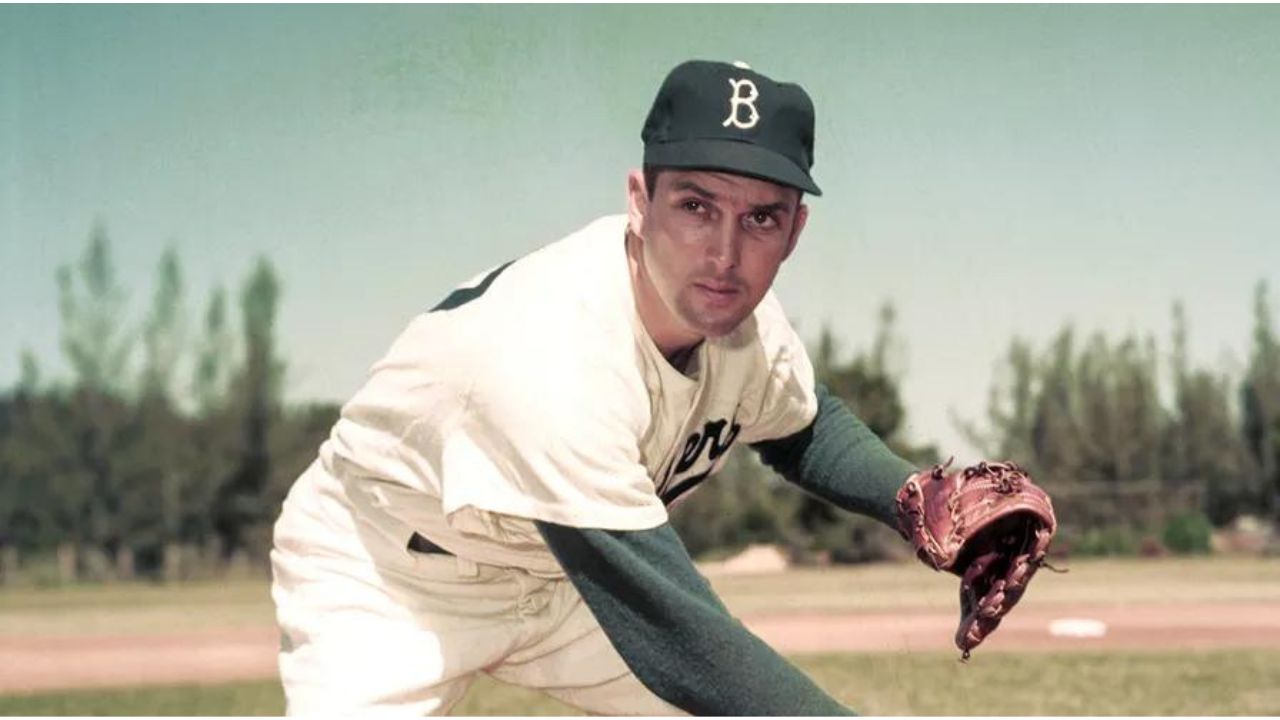Carl Erskine, a veteran of the Brooklyn Dodgers who pitched two no-hitters and won twenty games in 1953 after striking out a then-record fourteen in the World Series, passed away on Tuesday. He was ninety-seven.

According to Michele Hockwalt, the hospital’s manager of marketing and communications, Erksine passed away at Community Hospital Anderson in his hometown of Anderson, Indiana.
Erskine played his whole big league career with the Dodgers from 1948 to 1959, helping them win five National League pennants. Erskine was one of the few players left from the storied Brooklyn teams of the 1950s.
The right-hander finished his career with a 122-78 record, 4.00 ERA, and 981 strikeouts.
Erskine led the National League in his 20-6 season in 1953, his best season. He defeated the Yankees 3-2 at Ebbets Field to win Game 3 of the World Series. Before Dodgers ace Sandy Koufax struck out 15 in 1963, he had set a record by striking out 14 and retired the side in the ninth. The Dodgers ultimately suffered a six-game loss, and the Yankees captured their seventh straight championship.
After winning 18 games in 1954, Erskine became an All-Star.
He played in five World Series, including the one in which the Dodgers won their lone Brooklyn championship in 1955 after defeating the Yankees. After 3 2/3 innings, he left the game after giving up a home run to Gil McDougald in the opening inning of Game 4. The Dodgers proceeded to triumph 8–5.
With Erskine’s passing, Koufax, who is eighty-eight, is the only remaining member of the 1955 World Series Dodgers squad.
In July 2023, the board of directors of the Baseball Hall of Fame presented Erskine with the Buck O’Neil Lifetime Achievement Award, which is given to recognize an individual whose endeavours contribute to the good effects of baseball on society.
“For millions of fans, he was a baseball hero,” Hall of Fame chairman Jane Forbes Clark said in a statement. “For his family and thousands of Special Olympians, Carl was someone who always believed everything was possible. His legacy is one of deep compassion and encouragement of the human spirit.”
Anderson, Indiana, was the birthplace of Carl Daniel Erskine on December 13, 1926. At age 9, he joined a neighbourhood park program and started playing baseball.
He joined the Navy in 1945, just after receiving his high school diploma, as World War II was breaking out. After a year, Erskine inquired about playing baseball with the Navy recreation officer stationed there. Despite being rejected, he was released from the military a few weeks later after being scouted by the Dodgers.
Before making his major league debut on July 25, 1948, he spent the next year and a half in the lower leagues. With a 21-10 record in his first two seasons, Erskine started as a reliever.
He moved into the starting lineup in 1951, when he became one of the beloved “Boys of Summer,” along with teammates Roy Campanella, Carl Furillo, Gil Hodges, Jackie Robinson, and Duke Snider.
Erskine won 14 games and had a career-best 2.70 ERA in 1952. The next season, he set career highs with 187 strikeouts, 16 complete games, and a.769 winning % to lead the NL.
Erskine and Ralph Branca warmed up in the bullpen while teammate Don Newcombe was pitching in the ninth inning of Game 3 of the 1951 NL pennant with the New York Giants.
Branca relieved Newcombe on pitching coach Clyde Sukeforth’s advice, and Bobby Thomson hit the game-winning home run in the infamous “Shot Heard ‘Round the World.”
The best pitch Erskine ever had, when asked, was “the curveball I bounced in the Polo Grounds bullpen in 1951.”
Erskine pitched no-hitters against the Chicago Cubs in 1952 and the New York Giants in 1956, earning the nickname “Oisk” from fans with Brooklyn accents.
With two outstanding plays at third base, Bobby Morgan kept Erskine’s no-hitter intact against the Cubs.
“I made two super plays on swinging bunts where they just dribbled down the line and I fielded them one-handed and threw to Gil Hodges at first,” Morgan told The Oklahoman newspaper in April 2020.
Erskine, however, only lived in Los Angeles for one and a half years since he didn’t like being apart from his family. He retired at the age of 32 after throwing his last pitch in June 1959.
Erskine established an insurance company after moving back to his hometown, which is located 45 miles northeast of Indianapolis. During his twelve years as an Anderson College baseball coach, his team finished 20-5 and won the NAIA World Series in 1965.
In addition, he was involved in the community. From 1982 to 1993, he was president and director of Star Financial Bank.
In recognition of Erskine’s achievements in baseball and as an Anderson resident, a six-foot bronze statue of him was placed in front of the Carl D. Erskine Rehabilitation and Sports Medicine Center. He is honoured by a designated elementary school situated on land he gave. In 1979, he was admitted into the National Baseball Hall of Fame in Indiana.
Erskine Street in Brooklyn was named in his honour in 2002.
Erskine became an advocate for individuals with developmental disabilities after learning that his youngest son, Jimmy, had Down syndrome at birth. In his book “The Parallel,” he discussed how Jimmy and Robinson, Erskine’s teammate, challenged social norms. He has long been active in Indiana Special Olympics, where funds are raised by the Carl and Betty Erskine Society.
Erskine wrote two books named “Tales from the Dodger Dugout” and “What I Learned From Jackie Robinson.”
Read Also – All You Need To Know About Sade Robinson Who Went Missing
